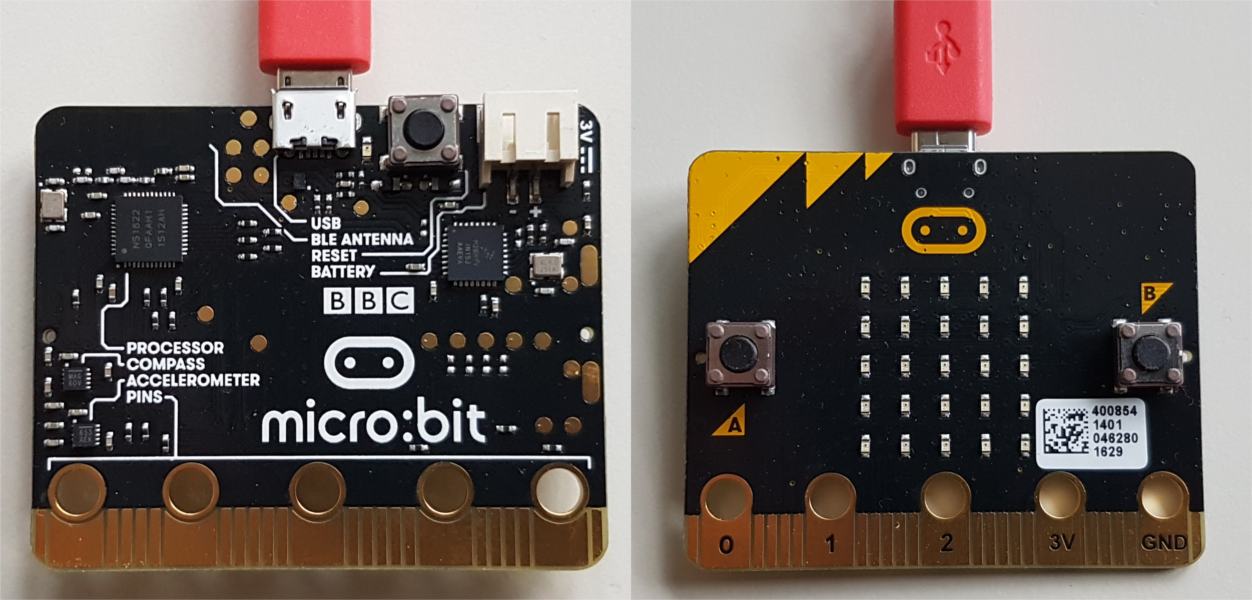mirror of
https://github.com/RIOT-OS/RIOT.git
synced 2025-01-15 10:32:44 +01:00
There were some random `bash` strings inside the code examples that are just confusing. Also we need to specify the board not only for emulation but for normal flashing too.
100 lines
3.6 KiB
Plaintext
100 lines
3.6 KiB
Plaintext
/**
|
|
@defgroup boards_microbit BBC micro:bit
|
|
@ingroup boards
|
|
@brief Support for the BBC micro:bit
|
|
|
|
## Overview
|
|
|
|
The [micro:bit](https://www.microbit.co.uk/) was designed by the BBC and
|
|
released in 2015. The boards was distributed to all 11-12 year old children
|
|
throughout the UK.
|
|
|
|
The board is based on the Nordic nRF51822 SoC, featuring 16KiB of RAM, 256KiB
|
|
of ROM, and a 2.4GHz radio, that supports Bluetooth Low Energy (BLE) as well as
|
|
a Nordic proprietary radio mode.
|
|
|
|
Additionally the boards features 2 buttons, a 5x5 LED matrix, a MAG3110
|
|
3-axis magnetometer, and a MMA8653 3-axis accelerometer.
|
|
|
|
|
|
## Hardware
|
|
|
|

|
|
|
|
| MCU | NRF51822QFAA |
|
|
|:----------------- |:--------------------------------- |
|
|
| Family | ARM Cortex-M0 |
|
|
| Vendor | Nordic Semiconductor |
|
|
| RAM | 16KiB |
|
|
| Flash | 256KiB |
|
|
| Frequency | 16MHz |
|
|
| FPU | no |
|
|
| Timers | 3 (2x 16-bit, 1x 32-bit [TIMER0]) |
|
|
| ADCs | 1x 10-bit (8 channels) |
|
|
| UARTs | 1 |
|
|
| SPIs | 2 |
|
|
| I2Cs | 2 |
|
|
| Vcc | 1.8V - 3.6V |
|
|
| Reference Manual | [Reference Manual](http://infocenter.nordicsemi.com/pdf/nRF51_RM_v3.0.pdf) |
|
|
|
|
|
|
## Flashing and Debugging
|
|
|
|
There are two possibilities to flash the board: using the default ARM DAPLink
|
|
or you can flash the board using Segger's JLink.
|
|
|
|
### DAPLink
|
|
|
|
The [DAPLink interface](https://www.mbed.com/en/development/hardware/prototyping-production/daplink/daplink-on-kl26z/) is the default way to flash the board and
|
|
works out of the box. When you plug the board to your host computer, it shows up
|
|
as a flash drive. To flash the board, you can simply copy your compiled `.hex`
|
|
file onto the board, and that's it.
|
|
|
|
The `micro:bit` port comes with a little script that does this automatically,
|
|
so you can flash the board as usual with
|
|
|
|
```
|
|
BOARD=microbit make flash
|
|
```
|
|
|
|
The DAPLink interface provides however not means for debugging the board.
|
|
|
|
### JLink
|
|
|
|
Recently, Segger released a JLink firmware for the interface MCU on the
|
|
`micro:bit`. You have to follow [these instructions](https://www.segger.com/bbc-micro-bit.html) to flash the JLink firmware on your `micro:bit`. Don't worry,
|
|
the process is very simple and you can revert the firmware back to the DAPLink
|
|
default anytime ([as described here](https://www.mbed.com/en/development/hardware/prototyping-production/daplink/daplink-on-kl26z/)).
|
|
|
|
Once you have flashed the JLink firmware, you can flash the board like this:
|
|
|
|
```
|
|
BOARD=microbit FLASHTOOL=jlink make flash
|
|
```
|
|
|
|
With the JLink firmware, you can now also do in-circuit debugging etc.
|
|
|
|
**Note: The current version of the JLink firmware
|
|
(JLink_OB_BBC_microbit_16-07-29.hex) does not support any serial port over USB,
|
|
so you can not use the RIOT shell with this firmware.**
|
|
|
|
|
|
### QEMU emulation
|
|
|
|
The microbit can be partly emulated by QEMU.
|
|
|
|
This requires at least QEMU 4.0 with ARM platform support enabled.
|
|
|
|
*NOTE*: not all peripherals are emulated. See
|
|
[this](https://wiki.qemu.org/Features/MicroBit) page for an overview.
|
|
E.g., there's no emulation for the radio, thus applications using that will
|
|
fail.
|
|
|
|
Use it like this:
|
|
|
|
$ cd examples/hello-world
|
|
$ BOARD=microbit make clean all -j4
|
|
$ BOARD=microbit make emulate
|
|
|
|
*/
|